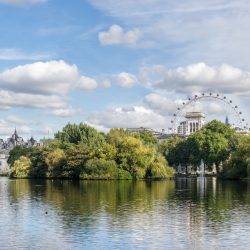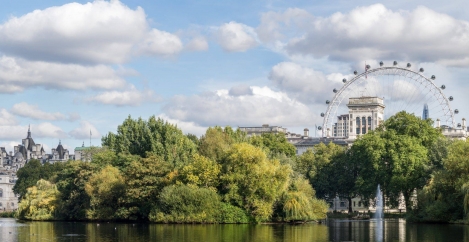August 15, 2017
London Mayor launches strategy to make the city “one of the greenest on the planet”
 The Mayor of London, Sadiq Khan has launched a new environmental strategy which he claims will help make the capital the world’s first ‘National Park City and one of the greenest cities on Earth’. The strategy includes plans for a new £9million Greener City Fund to boost trees and green infrastructure; improved planning policy proposals to encourage more green roofs, green walls and rain gardens; the creation of a ‘Challenge Map’ to prioritise areas in need of green infrastructure; and a series of measures to tackle pollution, promote cleaner energy & make more than 50 per cent of London green by 2050. As part of the strategy, the Mayor will use planning regulations to protect the Green Belt and incorporate into new developments more ‘green roofs’ (roofs covered with grass and plants which are excellent for soaking up rainwater), green walls (which can be added to the outside walls of buildings by busy polluted roads and are covered in plants to help boost air quality), ‘rain gardens’ (small green spaces which help prevent flooding), and habitats for wildlife.
The Mayor of London, Sadiq Khan has launched a new environmental strategy which he claims will help make the capital the world’s first ‘National Park City and one of the greenest cities on Earth’. The strategy includes plans for a new £9million Greener City Fund to boost trees and green infrastructure; improved planning policy proposals to encourage more green roofs, green walls and rain gardens; the creation of a ‘Challenge Map’ to prioritise areas in need of green infrastructure; and a series of measures to tackle pollution, promote cleaner energy & make more than 50 per cent of London green by 2050. As part of the strategy, the Mayor will use planning regulations to protect the Green Belt and incorporate into new developments more ‘green roofs’ (roofs covered with grass and plants which are excellent for soaking up rainwater), green walls (which can be added to the outside walls of buildings by busy polluted roads and are covered in plants to help boost air quality), ‘rain gardens’ (small green spaces which help prevent flooding), and habitats for wildlife.
The strategy was announced shortly before news emerged that the controversial plans for London Garden Bridge had been scrapped completely, despite the fact that up to £36 million of public funds may now be lost. Mayor Sadiq Khan has never favoured the Bridge and withdrew support for it last year, sealing its fate.
The strategy outlines Sadiq’s vision of making the city a greener, cleaner and healthier place by targeting London’s toxic air, and making London a zero-carbon city by 2050 with energy efficient buildings, clean transport and energy and increasing recycling. All this will boost London’s fight against climate change and help safeguard the health and wellbeing of all Londoners, according to the Mayor’s office.
As this is the first National Park City, the Mayor is working with partners across London, to set criteria for a National Park City, which will include:
- Protecting and increasing the amount of green space in the capital
- Increasing access to green spaces for Londoners of all ages, particularly in areas where there is currently a deficiency
- Increasing the quality of green spaces, ensuring they are well maintained and create healthy habitats for wildlife
- Valuing London green spaces, accounting for the health, environmental, social and economic benefits it brings to London.
The Mayor’s strategy proposals are designed to help London towards this goal and the aim of launching London as a National Park City at an international Summit in Spring 2019. His proposals include:
- Creating a ‘Challenge Map’ to highlight areas of London that should be priorities for green infrastructure investment as part of the Mayor’s target to make more than 50 per cent of London green by 2050
- Setting up a Green Spaces Commission to work with environmental experts to help boroughs attract investment, and transform and preserve their parks and green spaces
- Developing a new ‘Urban Greening Factor’ to ensure that green roofs, green walls – walls which are covered in plants and grass often by busy road sides and help lower pollution, trees and rain gardens are incorporated into new developments in London. The Mayor will also use his planning powers to protect our Green Belt and Metropolitan Open Land
- Targeting ‘grey’ areas to make them greener. With more Londoners living in flats and working in high rise offices, and with fewer people having access to private gardens, the Mayor wants to ensure more streets and public spaces become greener to improve health and encourage more walking and cycling.
Daniel Raven Ellison, National Park City campaigner said: “Making London a National Park City is an opportunity to improve the health of all Londoners. One of our main goals is to make the majority of London physically green and we very much looking forward to working with the Mayor on this target. The capital is famous for being a financial, cultural and political centre, but it’s an ecological centre too, with an incredible 14,000 species of wildlife, 3.8 million gardens and nearly as many trees as people. I look forward to working with the Mayor through the National Park City Foundation which is galvanising a movement to turn this big vision for London into a reality.”
In addition to the Mayor’s policies and programmes to green London, the draft London Environment Strategy includes:
- A comprehensive plan to ensure Londoners can breathe the cleanest air possible, including introducing the T-charge from October this year, plans to introduce an Ultra-Low Emission Zone (ULEZ) in 2019, and cleaning up the bus fleet. The new strategy also sets out the need for even tougher pollution targets proposed by the World Health Organisation to protect public health and starts to address the associated problem of indoor air quality.
- London’s first solar action plan which sets out the Mayor’s actions to more than double London’s solar energy generation capacity by 2030. Measures will include a new community energy grant scheme and a ‘reverse’ solar auction to help cut costs for Londoners who want to install solar panels on their homes.
- A new fuel poverty action plan to increase support for Londoners struggling to heat and power their homes affordably. This includes support through £10m energy efficiency delivery programmes, targeting the worst performing homes, as well as benefits uptake campaigns, referral services and programmes that provide direct advice and support to the fuel poor, and providing support to improve enforcement action against landlords who do not meet legal requirements.
- Policies to cut waste and encourage better use of resources, including setting minimum recycling standards to meet the Mayor’s target to recycle 65 per cent of London’s waste by 2030 and help cut food waste by 20 per cent per person by 2025
The measures have been broadly welcomed. John Alker, campaign and policy director at UK-GBC, said: “This draft plan outlines a number of important and ambitious policies, including proposals for all new buildings to be zero carbon from 2019, and for new large-scale schemes to be ‘Air Quality Positive’. The draft also proposes a new ‘Urban Greening Factor’ for new developments. These aspirations highlight the growing trend: it is our cities that are leading the way in the absence of policy ambition and clarity from central government. UK-GBC strongly welcomes this type of leadership and will be contributing the voice of progressive built environment businesses to this consultation. We look forward to engaging with the mayor’s office on the detail of these policies and maintaining the ambitions outlined.”
Mathew Frith, Director of Conservation, London Wildlife Trust, said: “The Mayor has made some welcome and challenging commitments to protecting London’s environment over the course of the next few years. We strongly support the development of his Environment Strategy, and hope its adopted policies and proposals will serve to make London a leader — once again — in developing innovative and rigorous approaches to urban greening. We look forward to continuing our work with the Greater London Authority to ensure that the city’s rich ecological assets are protected, and managed effectively, to ensure that the capital is a place where people can benefit from, and enjoy, the natural world around them. “
Cllr Julian Bell, Chair of London Councils’ Transport and Environment Committee, said: “I welcome the London Environment Strategy’s ambition for the capital to become a zero carbon city by 2050 and the acknowledgement of the role of other strategies, such as the Mayor’s Transport Strategy and London Plan within it. I look forward to reviewing the full strategy to ensure the role of the boroughs in improving London’s environment is reflected throughout. I am particularly pleased with the strategy’s approach to improving London’s green infrastructure. A greener London will not only be more pleasant to live in but will address the huge air quality problem London faces, support healthier lifestyles and help the city adapt to climate change.”














